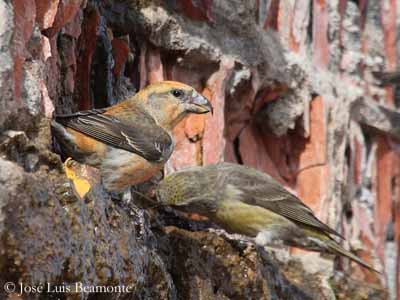
Fr: Bec-croisé des sapins
Ang: Red Crossbill – Common Crossbill
All : Fichtenkreuzschnabel
Esp : Piquitureto Común
Ital: Crociere comune
Nd: Grankorsnebb
Sd: Mindre korsnäbb
Photographers:
John Anderson
John Anderson Photo Galleries
José Luís Beamonte
Pájaros de España
Steve Garvie
RAINBIRDER Photo galleries & Flickr Rainbirder
Text by Nicole Bouglouan
Sources:
HANDBOOK OF THE BIRDS OF THE WORLD Vol 15 by Josep del Hoyo-Andrew Elliot-David Christie - Lynx Edicions – ISBN: 9788496553682
THE COMPLETE BOOK OF BRITISH BIRDS – Written by “Royal Society for the Protection of Birds” experts - Préface de Magnus Magnusson - Michael Cady- Rob Hume Editors - ISBN: 0749509112
THE HANDBOOK OF BIRD IDENTIFICATION FOR EUROPE AND THE WESTERN PALEARCTIC by Mark Beaman, Steve Madge - C.Helm - ISBN: 0713639601
ENCYCLOPEDIE DES OISEAUX DE FRANCE ET D’EUROPE – de Peter Hayman et Rob Hume - Flammarion – ISBN : 2082009920
L’ENCYCLOPEDIE MONDIALE DES OISEAUX - Dr Christopher M. Perrins - BORDAS - ISBN: 2040185607
FINCHES AND SPARROWS by Peter Clement, Alan Harris and John Davis – Helm Identification Guides – ISBN: 0713652039
Animal Diversity Web (University of Michigan Museum of Zoology)
Bird Web (Seattle Audubon Society)
What Bird-The ultimate Bird Guide (Mitchell Waite)
Pájaros de España (JL Beamonte)
Wikipedia, the free encyclopaedia
Red Crossbill or Common Crossbill
Loxia curvirostra
Passeriforme Order – Fringillidae Family
INTRODUCTION:
The Red Crossbill is found in the northern hemisphere. It does not migrate but it wanders widely after the breeding season. It frequents mature conifer forests where it can find its favourite food, the seeds of the pine cones. These birds have crossed mandibles, allowing them to take the seeds by entering the bill tips into the scales of the cones.
The Red Crossbill is monogamous and both mates seem to stay together throughout the year. The nest is built by the female, a cup-shaped structure placed between 3 and 35 metres above the ground in conifer. Both adults share the nesting duties.
The species is affected by forest fragmentation and increasing logging throughout the range, involving smaller cone crops. However, the population is suspected to be stable and currently, the species is not globally threatened.

DESCRIPTION OF THE BIRD:
Biometrics:
Length: 15-17 cm
Wingspan: 25-27 cm
Weight: 34-48 g
The Red Crossbill is a large, plump finch, with very distinctive bill.
The Red Crossbill adult male has brick-red plumage. The wings are dark greyish brown. The tail is blackish-brown. There are individual variations. Some males appear yellowish or orange-red. Others may be mottled greenish-yellow and red. Mantle and back may show some darker feathers. The rump is often brighter in colour.
The head is dull red but with brighter colours on forehead and crown.
The large bill has crossed mandible tips. It is thick and curved. The eyes are dark brown. Legs and feet are black.
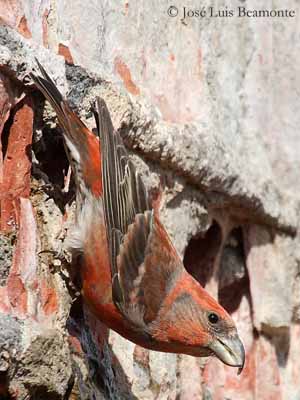
The adult female is dull greenish-yellow, with yellower rump. Upperparts are slightly streaked. Some females are duller with greyish colours.
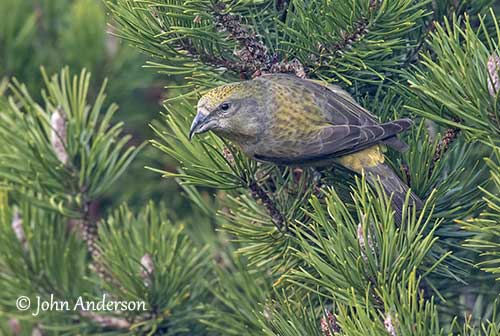
The juvenile is greyish-brown, heavily streaked dark overall. The streaked underparts are whitish. It has thin buffy wing bars, formed by pale fringes on fresh feathers.
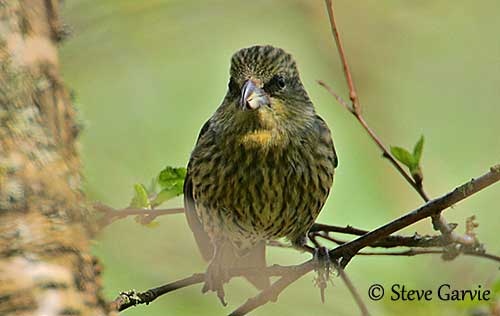
The immature resembles adult female, but some young males may show reddish or mixed red and yellow plumage.
SUBSPECIES AND RANGE:
There are 19 subspecies throughout the wide range.
These birds are the only birds having crossed bills in the world. The races may differ by the size of the bill, but mainly by the geographic distribution.
The Red Crossbill is found in North America, southern Alaska to Newfoundland, and southwards to northern United States, North Carolina and Central America. But the species also occurs across Northern Eurasia, northern Africa, south-eastern Asia and Philippines.
The species is resident in its breeding range, although it may move southwards according to food resources
HABITAT:
The Red Crossbill lives in coniferous forests, spruces or pines and it is rarely found away from conifers.
It usually breeds mainly in pine forest, but also in spruce, Douglas-fir and others. The forest type may vary according to each subspecies.
After breeding, flocks may appear in conifer plantations in urban parks, away from their usual range.
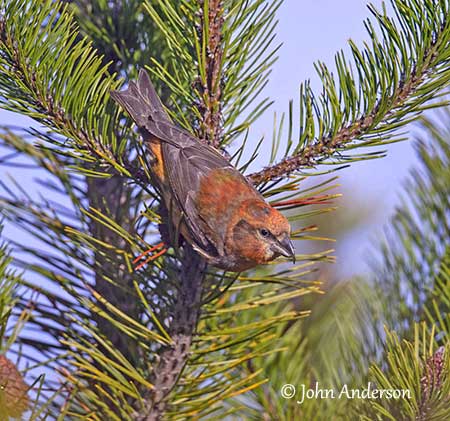
CALLS AND SONGS: SOUNDS BY XENO-CANTO
The Red Crossbill utters loud, persistent and explosive “chip-chip” calls. We can hear several other calls, a harsh “chewk” when alarmed or excited, and a ringing flight call “jip-jip-jip”.
The song is given from tree top of in display flight. It is described as a long, loud series of notes “cheeree-cheeree-choop-chip-chip-chip-cheedlee-cheeree” sometimes interspersed with light “tyi ti ti ti…” and a fluty warbling.
Both male and female may also utter soft sounds while feeding, such as a raising trill, a loud “jee” and a rattling “zeeerrr”, and concluding with soft “chip chip” notes.
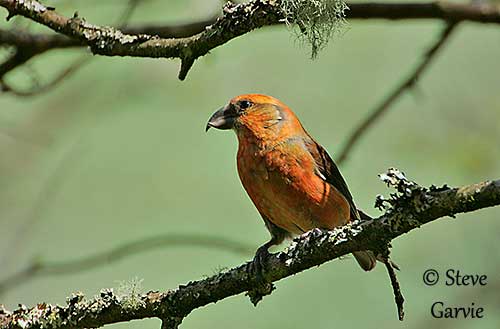
The Red Crossbills have different flight calls, and each type of sound is uttered by birds with different bill shape. Flocks maintain contact with distinctive flight call allowing the isolation of each group.
They also prefer to feed on seeds of different conifers with different size cones.
BEHAVIOUR IN THE WILD:
The Red Crossbill feeds on seeds of conifers, but they also consume buds of trees, weed seeds, berries and insects (aphids).
It feeds primarily on conifer seeds. It extracts the seeds with its crossed bill. It has strong asymmetrical jaw muscles, assisting the twisting movement necessary to extract the seed. The cone is broken from the tree with considerable effort. Then, the bird carries it on a branch, holding it firmly with the feet in order to extract each seed in repeated movements. It starts at the bottom of a cone, and spirals upwards, prying open each scale and getting the seed with the tongue.
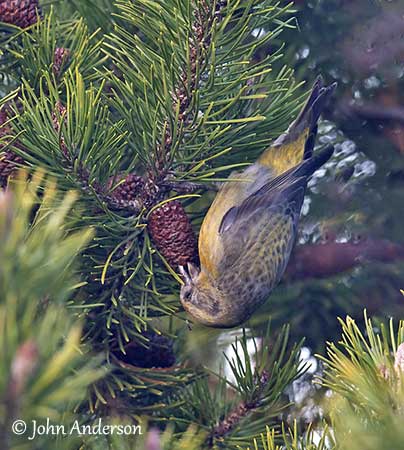
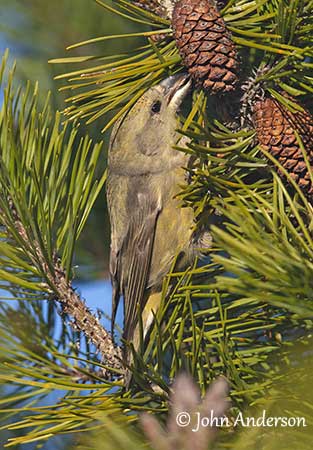
Increasing of conifer plantations makes these birds widespread in their habitat. They are detected by extracted seeds lying on the forest floor. They often feed in flocks.
The Red Crossbill pairs are monogamous, and form within the winter flocks. The pairs seem to remain together all the year but more information is required. The winter pairs might be different from the breeding pairs.
The male sings from perch and attracts females by aerial displays. The males become aggressive towards each other at this period. Courtship feeding is observed, and both mates grab each other by the bill. The male performs mate-guarding during the egg-laying to prevent extra-pair copulations.
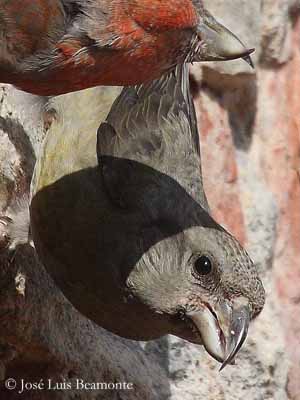
The Red Crossbills move according to the food resources, and they may irrupt out of their range is the food becomes scarce. For the same reason, they may breed in areas far south of their normal range. They breed when the food is abundant, at any month of the year, and several broods are produced if an abundant food source is found.
Birds in juvenile plumage may be seen all the year, except January and February, and family groups travel with juveniles still fed by parents.
The Red Crossbill performs a swift bounding flight with rapid wing beats. The flocks move through the tree tops.
REPRODUCTION OF THIS SPECIES:
The breeding season is usually determined by food abundance, and due to the irregular production of cone crops, this species may breed 2-3 times in a single year, and not at all in another year.
The Red Crossbill’s nest is located high in conifers, on horizontal branch, among a cluster of twigs and overhanging vegetation, in order to hide and protect it. The female builds the nest, a bulky cup made with loose twigs, grass and bark strips. It is lined with finer material such as grass, lichen, feathers and hair. The winter nests are more compact than the summer nests. Materials and constructions are different, according to the season.
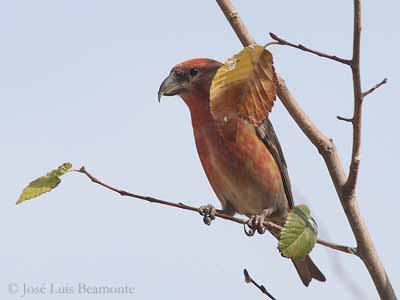
The female lays 3 to 4 pale blue-green eggs, spotted with brown and lavender. The incubation lasts about 12 to 16 days, by female. She is fed by the male by regurgitation during this period. The altricial chicks are fed by the male during five days, and then, both parents bring food to the young. They leave the nest about 18 to 22 days after hatching. They are still fed by parents for a month more.
Their bills are not crossed at hatching, but cross as they grow. They need 45 days to have their bills crossed enough to extract seeds themselves.
This species produces one or two broods per season, depending on the range.
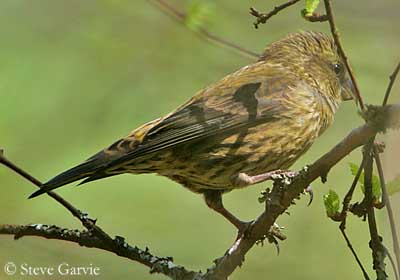
PROTECTION / THREATS / STATUS:
At this moment, the Red Crossbill is common and widespread in its wide range, but it depends of mature forests for food. Populations seem to be stable in most areas, but some declines are observed where deforestation is too rapid.
The global population was estimated at 15,000,000 individuals in 2004, but in 2015, a very preliminary estimate of this population was 91,000,000/173,000,000 mature individuals. But more information is required.
The Red Crossbill is not globally threatened and currently evaluated as Least Concern.
